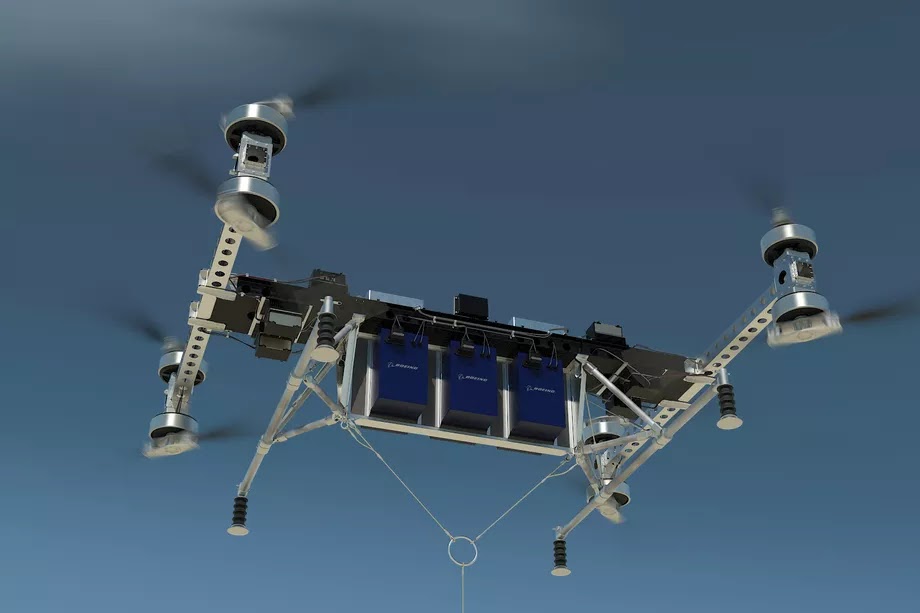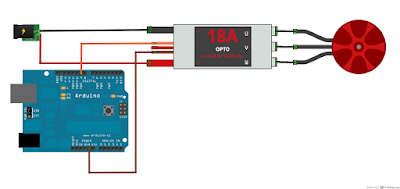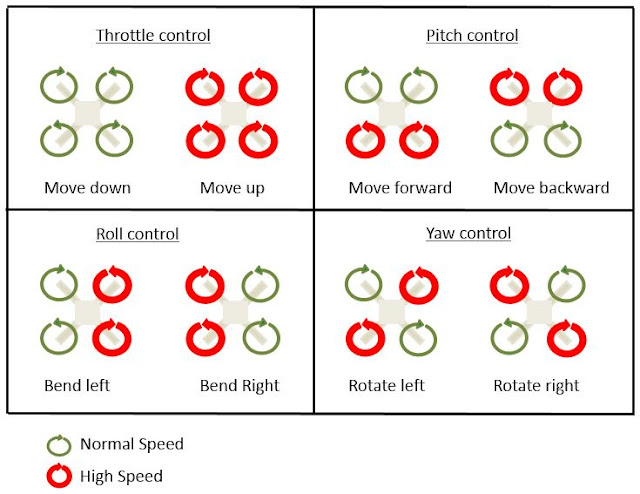Boeing New Drone Prototype can carry 500 lb (230 kg) - Theory and Review
 |
| New Prototype. Source: Boeing |
It's an era of drones. Everywhere we go, there are drones. They can be fixed winger or of rotary wing configuration. Boeing recently revealed their new and massive rotary winger drone that can lift and carry up to 500lb (230kg) which is freakishly awesome for such a class. They name it eVTOL (unmanned electric vehicle-takeoff-and-landing).
This giant drone is a Cargo Air Vehicle (CAV) which is meant to work with rescue services for humanitarian aid and taxi services such as Uber. Yes, we could see flying taxis soon. With keeping that in mind, this vehicle is autonomous with Boeing claiming that it could serve as a:
precursor for future autonomous flying aircraft.
Theory on Quadcopters to Get Started
Boeing's new prototype is an electric optacopter. This means this drone have eight rotary wings with four propellers on the top and four at the bottom producing an overall thrust to lift itself and the weight attached to it. But first we need to understand the basics of quadcopter before getting to know optacopters. |
| Scorpion Flycker 550 Quadcopter |
A normal quadcopter is made in such a fashion that two opposite propellers rotate in the same direction while other two in another same direction. This is done to cancel out the total momentum of both sides but generating a lift in straight up direction. If all propellers were to rotate in the same direction, a huge momentum will be generated in a specific direction, hence, quadcopter will swirl lift up. This swirl is the problem!
 |
| Arduino controlled BLDC motor attached to ESC. Source: robotic-controls.com |
By controlling the rotation of the four BLDC (Brushless DC) motors via ESC (Electronic Speed Controller), quadcopter can be made to move in forward, backward, right, and left direction. If you look in the illustrations below, you will find what Yaw, Pitch, and Roll means and what they do:
 |
| Source: amebaiot.com |
 |
| Source: dronenodes.com |
Note that for this article, we're going to discuss quadcopter designed in the fashion above. Concept is exactly the same for other configuration as well.
Pitching the quadcopter will control its forward and backward motion. This can be done by giving more power to the back two props meanwhile reducing the power in front props for forward motion. Vice-versa is done for backward motion. The reason is the increase in momentum on a side causing the imbalance of momentum and so the quadcopter moves forward or backward as a result to counter that imbalance. Simple laws of motion, isn't it?
Rolling the quadcopter will control its rightward and leftward motion or bend. This is done by giving more power to left props while reducing power to right props for rightward motion. Vice-versa is done for leftward motion. Physics is same as that of the pitch.
Yaw is simply the twisting of quadcopter about its vertical axis. This is done to change the direction of the front of quadcopter in whatever direction pilot wants, or perhaps an autopilot wants. Two opposite props are powered more while reducing the power in the other two.
Shifting the power needs to be done efficiently as possible as it can drain the battery pretty quickly. Power distribution board (PDB) is required for this power management. Such boards are directly connected to the main battery pack. Switch Mode Power Supply (SMPS) integrated modules are used to step up or step down DC voltages and regulate it to the attached components according to their requirements.
Piloting system with integrated PIDs (Proportional Integral Derivative) is used which uses received signals from the ground transmitter and makes the flight stable by a feedback loop using values from different sensors. PID consists of many other sensors such as Gyro.
Receiver is attached to the quadcopter which is connected to the piloting system. Specific channel transmitter (normally 6, 8, and 12 channel) is used for basic and advanced operations to send signals to quadcopter's receiver to perform specific actions accordingly. More features you want your flight to have, more channels you'll need. And this is how a quadcopter works!
Design of Boeing's Optacopter
Just like the quadcoptor, four more props are attached on bottom to achieve more thrust to lift the weight. Therefore, a much more sophisticated and advanced piloting system is required to make the flight successful. But this is not a bigger deal for Boeing engineers since they developed this heavy-duty payload carrier in just three months!All initial testing and flights were made in Boeing's Research lab in Missouri state, US. Check this video from Boeing:
Greg Hyslop, CTO Boeing says:
This flying cargo air vehicle represents another major step in our Boeing eVTOL strategy. We have an opportunity to really change air travel and transport, and we’ll look back on this day as a major step in that journey.
The dimensions of this eight motor electric powered CAV are something you might have never seen. It measures 15 ft (4.6 m) in length, 18 ft (5.5 m) in width, and 4 ft (1.2 m) in height, and weighs, astoundingly, 747 lb (340 kg). With attached payload it can weigh more than half a ton but Boeing never released the flight's altitude with or without payload attached. We can not really estimate the altitude as we really don't know the size of the propellers, power of the motors, and other complex design features.
Aurora Flight Sciences (AFS) has been working with Uber to launch CAV for taxi services was already a big news. Now that Boeing has acquired AFS just four months before their launch of this drone seems to be more promising with AFS research and development of flying taxis with services like Uber and others.
So right now, we have definitely more to come from this side of electronics and aerodynamics.








 #ref-menu
#ref-menu
This video shows the rapid development of drones as deadly munition. These drones have an embedded warhead instead of simply dropping bombs, as we have become somewhat accustomed to with ISIS. CUAS
ReplyDeleteThe DGS team recognizes that drone technology is evolving continuously, generating new and more significant challenges like drone swarms using pre-programmed drones. With increasing demand for countermeasures, Drone Detection
ReplyDelete